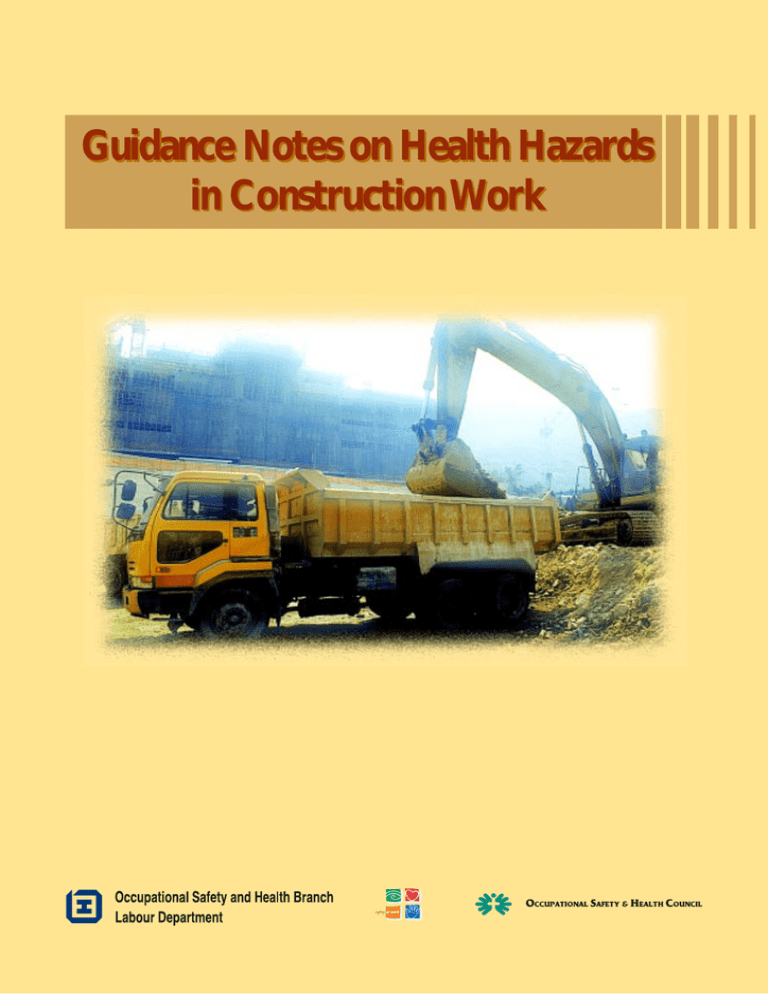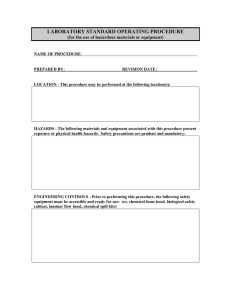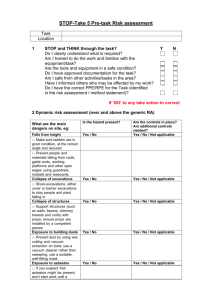Guidance Notes on Health Hazards in Construction Work Guidance
advertisement

Guidance Notes on Health Hazards in Construction Work This guide is prepared by the Occupational Safety and Health Branch Labour Department This edition February 2004 T h i s g u i d e i s i s s u e d f r e e o f c h a r g e a n d c a n b e o b t a i n e d f r o m o ff i c e s o f t h e Occupational Safety and Health Branch, Labour Department. It can also be downloaded from http://www.labour.gov.hk/eng/public/oh/OHB82.pdf. Addresses and telephone numbers of the offices can be found in the website http://www.labour.gov.hk/eng/tele/osh.htm or by telephone 2559 2297. This guide may be freely reproduced except for advertising, endorsement or commercial purposes. Please acknowledge the source as “Guidance Notes on Health Hazards in Construction Work”, published by the Labour Department. Guidance Notes on Health Hazards in Construction Work CONTENTS Introduction 1 Principles of Health Protection 1 Health Hazards 4 Further Reading 9 Further Information 9 HEALTH HAZARDS IN CONSTRUCTION WORK Introduction Workers in a construction site may be exposed to various hazardous substances and physical agents, e.g. asbestos, lead, silica dust, organic solvents, sewer gases, welding fumes, radiation, noise and vibration. Excessive exposures to these substances/agents may result in acute injury, chronic illness, permanent disability or even death. Loss of concentration at work and fatigue arising from poor health conditions may increase the risk of accidents. Construction work is featured by high labour turnover, constantly changing work environment and conditions on site, and different types of work being carried out simultaneously by several contractors. These features would further increase the health risks of workers. Principles of Health Protection Hazard Identification To prevent health hazards at work, all possible health hazards that may be encountered should be identified before commencement of construction work. The health hazards at a construction site may come from the hazardous substances used or those already present on site. The environmental conditions may also create additional health hazards. These factors should also be identified, for example, heat and noise. The information for hazard identification can be obtained from the equipment and material supplier, site owner and principal contractor. If such information is not available, then a contractor should take actions to identify unknown substances or seek assistance from a specialist if necessary. Risk Assessment Risk assessment is the process to look at the conditions workers are exposed to the hazards and determine whether the hazards likely to cause any harm to the workers. Assessment of risks may be made by considering factors such as: • the air concentration of fumes, vapours and dust generated from the work processes; • the effectiveness of ventilation on site to control the air contaminants; Health risks at work should be assessed to ensure that the workers are adequately protected. GUIDANCE NOTES ON HEALTH HAZARDS IN CONSTRUCTION WORK 1 • the likelihood of skin or eye contact with corrosive/irritating substances; • the exposure of the workers to hazardous physical agents, e.g. noise, heat and radiation; • the ergonomic factors, e.g. repetitive tasks and manual handling. Both the immediate risks, e.g. being overcome by fumes in a confined space, and the long term health risks, e.g. skin cancer from prolonged contact with pitch, should be assessed. The assessment should be reviewed when new hazardous substances and physical agents are used and when there is a significant change in the working environment. Prevention When health hazards are identified, the first step is to try to eliminate them completely. It means either: • Doing the job in a different way, for example, instead of using acids or caustic soda to unblock a drain, use drain rods; or • Using a substitute, for example, instead of using spirit-based paints, use water-based ones which are generally less hazardous. However, always check that one hazard is not simply replaced by another. Control If prevention is not practicable, the next step is to try to control the risk. The control methods may include: • ensuring adequate ventilation in the working area; • using as little hazardous substances as possible; • applying local exhaust ventilation to particularly hazardous processes, e.g. rock cutting and grinding and welding; • using water suppression to control dust emission; • segregating hazardous process so that workers not directly involved are not affected; • administrative measures, like providing sufficient safety and health training, instructions and information to the workers, appropriate supervision, good personal hygiene and good housekeeping. Provide exhaust ventilation to work areas where natural ventilation is insufficient. 2 GUIDANCE NOTES ON HEALTH HAZARDS IN CONSTRUCTION WORK Personal Protective Equipment If, and only if, exposure cannot be adequately controlled by any combination of the measures already mentioned, personal protective equipment should be provided. These may take the form of: • respiratory equipment for protection against dusts, vapours or gases; • protective clothing, such as overalls, boots and gloves for protection against irritating and corrosive substances, abrasion and vibration; • eye protectors for protection against chemical splashes, such as goggles or face visors. The personal protective equipment should be selected with care. A personal protective equipment programme, including selection, maintenance, user training and supervision, should be set up to ensure the effectiveness of the personal protective equipment. Medical Surveillance Medical surveillance is basically a system of monitoring the health status of workers engaged in hazardous occupations. The objective is to detect early signs of illness so that intervention may be taken to prevent permanent health damage. This is particularly useful for occupational illness with long latent period, like silicosis and occupational deafness. Workers engaged in hazardous occupations should undertake pre-employment and periodic medical examinations. The examination should be done by a medical practitioner with sound knowledge in occupational medicine. It is recommended that the following occupations in the construction industry should undertake pre-employment and periodic medical examination because they may have prolonged exposure to a high concentration/level of hazardous substances and/or physical agents. GUIDANCE NOTES ON HEALTH HAZARDS IN CONSTRUCTION WORK 3 Occupation Decoration and maintenance worker Bar bender and fixer, bricklayer, leveller, plumber, plasterer, carpenter, labourer, etc. Ground investigation operator/pneumatic driller/borer, excavating worker, concrete worker, mason, earthmoving machinery operator Metal worker, piling operator Painter Carpenter (formwork) Hazardous Exposure Excessive noise (85 - 89 dB(A)) Excessive noise (85 - 89 dB(A)) Excessive noise (≥ 90 dB(A)) Silica Excessive noise (≥ 90 dB(A)) Solvent containing benzene Methylene-di-isocyanate (MDI), Toluene-di-isocyanate (TDI) Excessive noise (85 - 89 dB(A)) Asphalter, road worker Tar, pitch, bitumen and creosote Silica Excessive noise (85 - 89 dB(A)) Surveying technician (land) Laser Asbestos worker Asbestos Compressed air worker, diver Compressed air Excessive noise (≥ 90 dB(A)) Silica Welder, blacksmith Excessive noise (85 - 89 dB(A)) Welding fumes Lead, Cadmium, Manganese On the relevant statutory medical examination requirements for construction workers, reference could be made to the Factories and Industrial Undertakings Regulations, the Factories and Industrial Undertakings (Work in Compressed Air) Regulations and the Factories and Industrial Undertakings (Asbestos) Regulation. Health Hazards Health hazards in the construction industry can be grouped under chemical hazards, physical hazards and ergonomic hazards: • Chemicals can affect the body via inhalation, ingestion, or skin absorption. • Physical hazards include noise, heat, vibration and radiation. • Ergonomic hazards include mainly manual handling of loads. Silica dust Silica is a major component of the earth's crust. Besides, a lot of building materials, like natural stone, bricks and concrete contain silica. Therefore workers are widely exposed to it. Any process involving breaking, crushing or grinding silica containing materials will generate silica dust. The workers at high risk include operators of pneumatic breakers, drillers and masons. 4 GUIDANCE NOTES ON HEALTH HAZARDS IN CONSTRUCTION WORK Exposure to excessive dust for prolonged period can lead to silicosis, a disease with lung fibrosis causing difficulty in breathing. The risk is highest in confined spaces with poor ventilation, for example, caissons and tunnels. Water suppression is usually an effective and economic means to reduce the dust level. If engineering control measures are not possible to control the dust to an acceptable level, adequate and suitable respiratory protective equipment should be provided and worn by workers at risk. Lead dust Lead dust may arise from handling materials containing lead or its compounds, such as removal of leaded paint and handling of metallic lead. Lead fumes may arise from hot cutting and dismantling tanks previously containing lead compounds. Excessive exposure may cause acute or chronic health effects. Welders and flame cutting operators may be at high risk. Contractors are required to assess the nature and degree of exposures to lead, to take appropriate measures to control the exposure, to inform the workers of the risks involved and to provide washing and changing facilities. Asbestos dust Asbestos can cause asbestosis (diffuse fibrosis of the lung), mesothelioma (cancer of the lining of the chest and abdomen) and lung cancer. Smoking further increases the risk of lung cancer for those exposed to asbestos. Asbestos dust will be generated whenever materials containing asbestos are disturbed. These materials include sprayed asbestos coatings, thermal and acoustic insulation materials, fire resistant walls and partitions, asbestos cement sheets and flooring materials. Demolition work on asbestos insulation and sprayed asbestos coating can produce particularly high level of dust. These materials should be removed by competent asbestos contractors before commencement of demolition work. Asbestos containing materials should not be demolished without adequate worker protection. All work involve asbestos and the required safety precautions are regulated by the Factories and Industrial Undertakings (Asbestos) Regulation and the Code of Practice on Safety and Health at work with Asbestos. Disposal of materials containing asbestos has to be carried out in accordance with the Enviromental Protection Department requirements. GUIDANCE NOTES ON HEALTH HAZARDS IN CONSTRUCTION WORK 5 Gases, vapours and fumes Gases, vapours and fumes may be released from a variety of processes, including: • welding and flame cutting; • using internal combustion engines and LPG burners; • burning of waste materials; • painting - particularly paint spraying; • using adhesive and thinners. The harmful effects depend on the types, toxicity and concentration of the gas and vapour present in the working environment. Some can overcome the worker quickly while others can have long-term health effects. Adequate ventilation must be provided and suitable respiratory protective equipment worn where appropriate. Entry into confined spaces In the course of work, if entry into confined space is required, extra precautions are necessary. Problems encountered include oxygen deficiency and inhalation of toxic or inflammable gases like carbon monoxide, methane, hydrogen sulphide, etc. Entry into a confined space is regulated by the Factories and Industrial undertakings (Confined Spaces) Regulation. A safe system of work should be established by the proprietor or contractor responsible for the operation in the confined space. The system should include, but not limited to, a risk assessment, appropriate safety precautions, use of personal protective equipment, emergency procedures and training. Monitor for hazardous contaminants before entering a confined space. 6 GUIDANCE NOTES ON HEALTH HAZARDS IN CONSTRUCTION WORK Other chemicals Many substances encountered in construction work would harm the skin: • Mineral oil or pitch may cause skin cancers on prolonged contact. • Disinfectant, bleaches, solvents, oils, acids and alkalis may cause irritation. • Epoxy resins, acrylic resins, formaldehyde, nickel, cobalt, chrome, natural gums and vegetation, including timber may cause allergic reactions. If skin contact with these substances is inevitable, suitable protective clothing and gloves should be worn. Washing of hands after work and skin care are essential to prevent dermatitis. However, solvents should never be used to clean hands or other body parts. Noise High noise level can distract concentration, cause difficulties in speech communication and increase the risk of accidents. Long term exposure to excessive noise can cause permanent hearing damage. Construction plants, such as compressors and concrete breakers frequently create very loud noise level. Exposure to noise at work should be assessed and controlled. Whenever possible engineering controls should be implemented to reduce the noise level at source. If it is not possible to reduce the noise to below the control limit, suitable hearing protectors must be worn. Ionizing radiation Ionizing radiation is used for detecting weakness of metal structure on a construction site. Radioactive substances which have previously been stored or used may be released in demolition of buildings. Construction workers exposed to such ionizing radiation may have increased risk of developing cancer and genetic disease. Recognized safe system of work must be observed, including, for example, isolation, segregation of workers, installing warning notices and signs (Trefoil sign), monitoring and decontamination. If in doubt, advice should be sought from the Radiation Health Unit, Department of Health. (Tel. 2886 1551) The above sign indicates presence of ionizing radiation. GUIDANCE NOTES ON HEALTH HAZARDS IN CONSTRUCTION WORK 7 Vibration Many jobs in construction involve the use of hand-held power tools such as pneumatic breakers and disc grinders. The vibration from such equipment may cause carpal tunnel syndrome. The disease affects the fingers and hands. In the long run, permanent damages to the nerves will result in a loss of the sense of touch and dexterity. Where possible, low vibration tools should be used. They should also be properly maintained so that they are balanced and have no loose parts. Wearing anti-vibration gloves can also reduce the harmful effect of vibration. Heat Long term exposure of the hands to vibration may cause Carpal Tunnel Syndrome. Prolonged work under direct sunlight in summer without precautions may cause heat rashes, heat cramps, heat exhaustion and even heat stroke. The problem may be aggravated if impermeable protective clothing is worn when undertaking heavy work or working in an enclosed area with a strong heat source, poor ventilation and high humidity. Examples are removal work for asbestos insulation, underground work and maintenance of boilers. The best strategy to prevent heat stress is to avoid heavy manual work in hot environment. Consider if the work can be accomplished by mechanical means or done in cooler parts of a day or season. Heat stress can be reduced by providing shelter, blowing fans, adequate cool drinks to replace the water lost as sweat and sufficient rest breaks. Manual Handling Manual handling is common in construction work and is one of the most common causes of injury at work. Many manual handling injuries are often the result of carrying out these operations for a long period, but even one bad lift can cause a lifetime of pain and disability. The Occupational Safety and Health Regulation requires the responsible person of a workplace to make a preliminary assessment of all manual handling operations before work and to avoid the need to undertake hazardous manual handling operations as far as reasonably practicable. Where avoidance is not reasonably practicable, the responsible person has to make a further assessment and reduce the risk of injury by providing mechanical aids or team lifting. 8 GUIDANCE NOTES ON HEALTH HAZARDS IN CONSTRUCTION WORK Poor manual lifting posture is a common cause of injury on a construction site. Further Reading 1. The Protection of Workers' Health Series - Silica 2. Guidance Notes on Protection of Quarry and Construction Workers from Silicosis 3. Respirator for Silica Dust 4. Code of Practice for Control of Lead at Work 5. Code of Practice on Safety and Health at Work with Asbestos 6. Health Hazards of Welding 7. Code of Practice on Safety and Health at Work in Confined Spaces 8. The Protection of Workers' Health Series - Solvent 9. Prevention of Occupational Dermatitis - Guidelines for Employers and Employees 10. The Protection of Workers' Health Series - Respiratory Protective Equipment 11. Guidance Notes - Factories and Industrial Undertakings (Noise at Work) Regulation 12. The Elements of Heat Stroke !"#$(Chinese version only) 13. Work Safety - Prevent Heat Stroke in Hot Working Environment !"#$%&'()*+,-(Chinese version only) 14. Guidance Notes on Manual Handling Operations 15. A Guide to Part VII of the Occupational Safety and Health Regulation (Manual Handling Operations) Further Information This guide is not intended to give an exhaustive list of possible health hazards in the construction industry. The above information describes the major hazards. It may be used by contractors and concerned persons to identify the health hazards that may be present in their sites and to adopt appropriate preventive measures. When in doubt, advice may be obtained from the Occupational Health Service of the Labour Department. Address : 15th floor, Harbour Building, 38 Pier Road, Central, Hong Kong. Telephone: 2852 4041 Facsimile : 2581 2049 Website : http://www.labour.gov.hk E-mail : enquiry@labour.gov.hk Information on the services offered by the Occupational Safety and Health Council can be obtained through hotline 2739 9000. GUIDANCE NOTES ON HEALTH HAZARDS IN CONSTRUCTION WORK 9 02/2004-2b-OHB82



